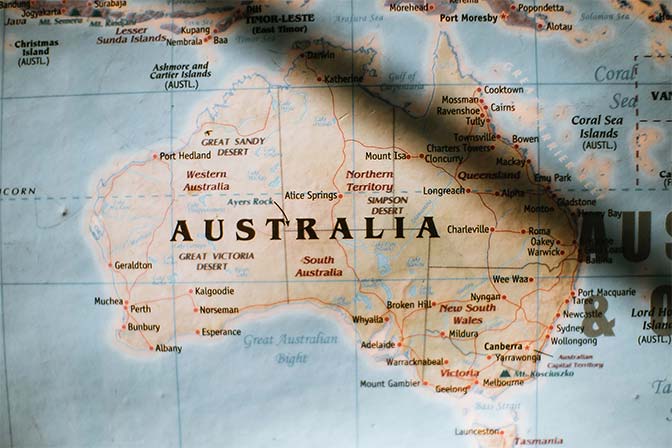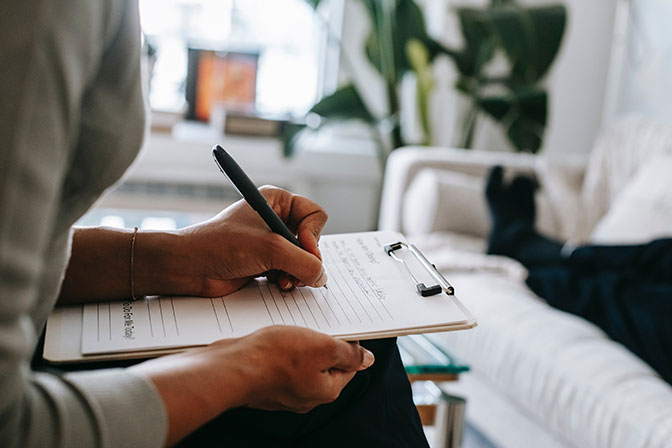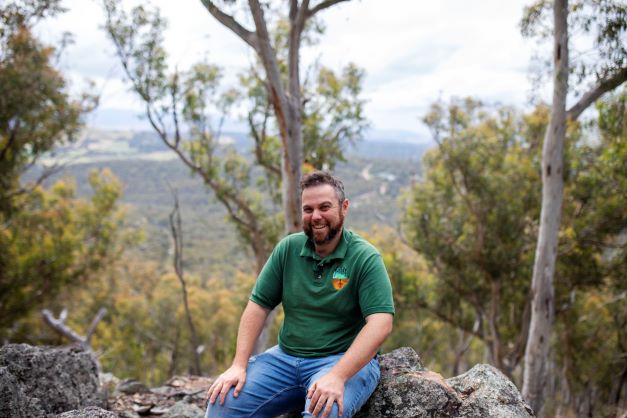LEARNING ACTIVITY
STORY
Jarrah and his younger cousin Alira were both brought up in Canberra - Ngunnawal Country. They have cousins and family in many parts of the Country including in their home town of Bathurst - Wiradjuri country and in Batemans Bay - down in Yuin Country. The grew up understanding the importance of acknowledging the Traditional Owners of the lands they live on, and to pay respect to local custodians of that area.
Jarrah enjoys hearing from his cousins and from Adam, who is from Dubbo Wiradjuri Country, about what is special to them about their Country. Sometimes Adam will teach Jarrah words from Wiradjuri language. Today, they practiced the Wiradjuri word Murnong for the Yam Daisy that they had recently planted.

This activity introduces the Aboriginal and Torres Strait Islander peoples as the First Nations peoples of this Country. They are the traditional custodians of the lands, waterways and skies across Australia and it is important for us to recognise that.
A Welcome to Country and an Acknowledgement of Country are opportunities for all people to show respect to Aboriginal and Torres Strait Islander peoples and cultures, and build understanding of their languages and connections to Country.
Anyone can do an Acknowledgement of Country to acknowledge the Country that they are on. Only an Elder from that Country can do a Welcome to Country.
Learning about Aboriginal and Torres Strait Islander languages can help children build their understanding of land, water and people. This activity helps to assist the identification of the language group/s on which the school, youth group or home is situated.
To understand local perspectives and support these activities, we recommend reaching out to the local Traditional Owners and First Nations peoples who can assist in knowledge sharing and understanding the local land, histories and culture. This is an important consideration to ensure that any reconciliation initiatives are being driven in a local, meaningful way.
For children to:
- understand that the Aboriginal and Torres Strait Islander Peoples are the traditional custodians of Australia’s land, waterways and skies
- learn that Australia is made up of many different communities of First Nations peoples and there is a variation between and within each group
- appreciate the diversity of Aboriginal and Torres Strait Islander peoples across Australia identify the language group in their local area.
This activity can be done at any time of the year.
Introduction
This activity introduces children to a First Nations peoples languages map and builds an understanding and appreciation of the language and culture of local Aboriginal and Torres Strait Islander peoples.
Adam Shipp a Wiradjuri man shares the following:
“Language is a part of everything we do. It is in our country, our rocks, trees and landscapes. For Aboriginal and Torres Strait Islander people it is important for us to connect and reconnect to language of our ancestors and to speak this language every day. We believe our ancestors are always watching over us, so to speak our native tongue is to connect directly to them.”
Checklist
Instructions

STEP 1
Begin this activity at your location with an Acknowledgement of Country. By acknowledging the Land, you are also making a promise that you will care for the land, the waterways, the plants and the animals.
Use the story to encourage the children to talk about their understanding of First Nations peoples languages. What did they learn from the story? What do they know about the languages of First Nations peoples? Have they heard anyone speak in these languages? Do they know some words for their local language group?
Listen and watch the Marin Gamu song where schools around Australia sing this song about body parts in their local language. Marrin’ and ‘Gamu’ mean ‘body’ in the Kalaw Kawaw Ya (Torres Strait) and Wiradjuri (NSW) languages.
Do you know any other songs about the body in language other than English? (example Head, Shoulders, Knees and Toes)
Not only are there many different First Nations communities across Australia there are a great diversity of languages and therefore diversity of cultures. These languages are complex and diverse as are the people.
Who could we ask to find out more about local language? Use this opportunity to invite local Aboriginal and Torres Strait Islander community members and people involved in language revitalisation work to help you explore First Nations Peoples’ culture and language for the people in your local area.
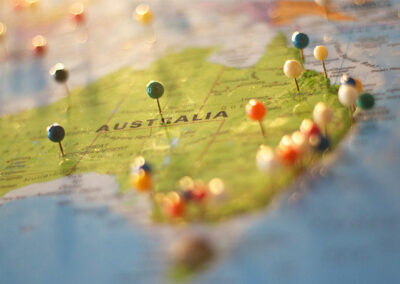
STEP 2
Use the online Gambay First Languages Map to explain the significance of language. Tell the children that each language group had an important relationship with their Country and between Countries. No part of Australia was empty or without people. Language is important for identity.
Find the location of your setting on a map of Australia. Find that same location on the Gambay First Languages Map to find the name of the group where your school, youth group or home is located.
Use this Language Map to compare with a map of Australia showing the states and Territories.
How are they different? Compare the sizes of the groups? Why would they be different sizes? How would the groups differ across Australia? What role would the type of environment and climate play in where people live?

STEP 3
Take some time outside to sit quietly and listen for 2 minutes. What do you hear – are there any sounds of animals or other natural environment sounds?
Explain safe and respectful behaviors and then give children the opportunity to explore for natural objects on the Country they are on. What can they find that makes them feel connected to place?
Discuss with the children what they have found on Country and how it makes them feel.
Discuss with the children how they might be able to look after the Country they are on. What other ideas do they have and what actions can they take? What can they do to show they feel thankful?
Discuss that an Acknowledgement of Country is way of saying what we are thankful for – we are thankful for the land, the water the plants, the animals, the people and looking after each other.
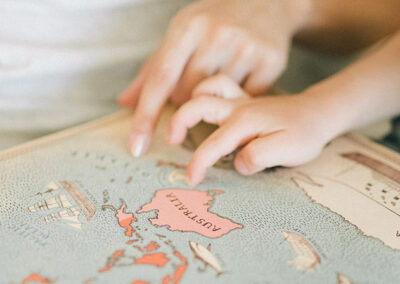
STEP 4
Find your location on a map of Australia. Find that same location on the Language map to find the name of the group where you are located.
Use your research to add answers to the activity sheet.
Write an Acknowledgment of Country in the activity sheet. You can draw significant places, plants or animals for your Acknowledgment of Country.
Find the language groups for some of your favorite Australian locations on your sheet.
Explore some more local language uses with local Community Elders; use the online resources provided in the reference list to help you. Use the Welcome to Country App and search for your location on the map. Listen to a Welcome in the local language (if available).
Extension Activity
Extension 1
Find out the Country or language group for each of Australia’s capital cities.
Extension 2
Listen to the First Nations peoples language words from your location on the interactive 50 words map from the Research Unit For Indigenous language from the University of Melbourne and practice saying them.
Curriculum and Framework Links
ENGLISH
Year 2 ACELA1460
Year 3: ACELA1475
Year 4: ACELA1487
Year 5: ACELA1500
Year 6: ACELA1515
GEOGRAPHY
Year 2: ACHASSK049
Year 3: ACHASSK062, ACHASSK066
Year 4: ACHASSK083, ACHASSK089
Year 6 ACHASSK140
HISTORY
Year 2: ACHASSK045
Year 3: ACHASSK062
Year 4: ACHASSK083
Year 5: ACHASSI095
SCIENCE
Year 2: ACSHE035
Year 3: ACSHE051
Year 7: ACSHE223
CROSS CURRICULUM PRIORITY
Aboriginal and Torres Straight Islanders Histories and Cultures
Sustainability
GENERAL CAPABILITIES
Literacy
Numeracy
Critical and Creative Thinking
Personal and Social Capability
Ethical Understanding
Intercultural Understanding
MY TIME, OUR PLACE: FRAMEWORK FOR SCHOOL AGE CARE
Outcome 2 and 4
Reference List
The maps provided here are representations only. We encourage you to connect and consult with your local Aboriginal and Torres Strait Islander community for appropriate language advice.
ONLINE RESOURCES
The Narrgunnawali My Acknowledgement of Country (Early Learning) and Languages Map (Early Learning) activities on the Narragunnawali platform provide resources and activities on the practice of Acknowledging Country and use of Aboriginal and Torres Strait Islander language maps.
First Languages Australia is working with regional language centres nationally in the development of this Gambay – First Languages Map of Aboriginal and Torres Strait Islander languages that reflects the names and groupings favoured by community.
You can learn more about the Gambay – First Languages Map from ABC Education.
You can view the AIATSIS map of Indigenous Australia and look more closely using a magnifier to find language, tribal or nation groups of First Nations peoples.
The Languages Subject Guide on the Narragunnawali platform can provide guidance on how to effectively embed ideas on reconciliation, and First Nations peoples histories, cultures and contributions, within the specific subject/learning area of Languages.
PRINTABLE RESOURCES
Aboriginal Australia Wall Map from AIATSIS (D R Horton)
APPLICATIONS
The Welcome to Country App (Apple) provides a short video Welcome to Country of a traditional owner or elder.
WATCH
Choose from this selection of videos from children all around Australia singing in Language from Marrin Gamu.
Learn to count to ten in Kaurna, the language of the Kaurna people of Adelaide from ABC Education. (3 minutes)
Excerpts from Play School: Acknowledgement of Country episode including the ‘Hand in Hand’ song which gives an Acknowledgement of Country and celebrates Australia’s First peoples. (1 minute 45)
LISTEN
The Little Yarns Podcast co-listening podcast series for is a listening resource for families and children to explore the diverse languages, stories and countries of Australia.
READ
Source children’s books in Aboriginal and Torres Strait Islander people’s language from Magabala Books, a publishing house owned and led by First Nations peoples.
NETWORK
We recommend reaching out to the Local Traditional Owners and First Nations peoples community groups who can assist in knowledge sharing and understanding local land, language, stories and culture. To reach out or find contacts in your local you could speak to parents of First Nations students, to an Indigenous Learning Officer (ILO) at your school, local Land Council or a local Landcare group. Engaging with these resources can contribute to a wider school and community reconciliation initiatives, including a schools Reconciliation Action Plan (RAP).
We have some suggested organisations to approach listed on our Junior Landcare Community page and in more detail within our Educator Notes.
Why not try one of our other Junior Landcare learning activities?
Creating an Indigenous plant-use garden: plant list
First Nations Perspectives
Creating an Indigenous plant-use garden: resources from the bush
First Nations Perspectives
Love Letters to the Land
Biodiversity|First Nations Perspectives|Food Production|Waste Management
Creating a yarning circle: involving First Nations people
First Nations Perspectives
